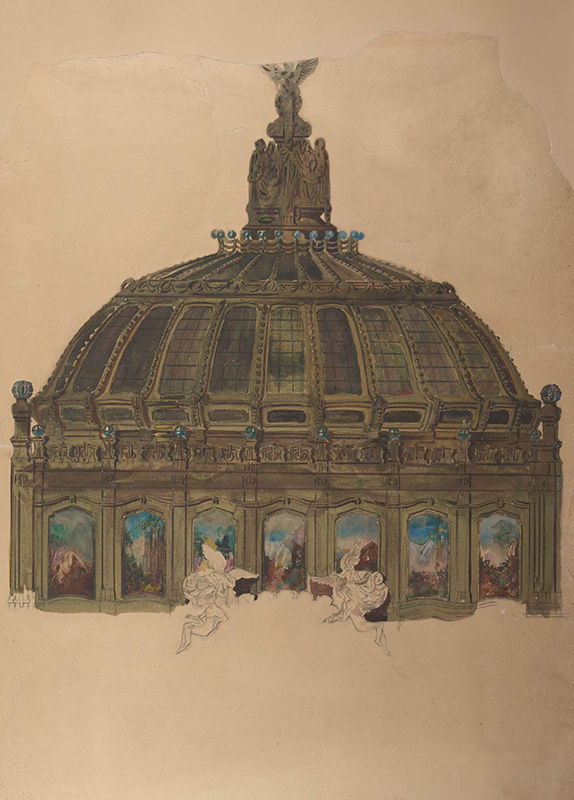A Time-Traveling Tale of Glass in America
- Eduardo Montes-Bradley

- Aug 18
- 4 min read
Updated: Aug 20
When I first heard of Louis Comfort Tiffany, it wasn’t through textbooks or museum galleries—it was at my family’s dining table in Buenos Aires. Suspended above us was a chandelier we proudly called a “Tiffany,” its glowing colors casting a warm spell over our meals. Was it a true Tiffany or a reproduction? We never knew for sure, but to us, it was a treasure, a shimmering piece of art nouveau magic. Years later, I heard whispers of a Tiffany window gracing the ceiling of Café Tortoni, Buenos Aires’ legendary haunt. That, too, was a myth—the stained glass came from France, as the Europhile Argentine elite of the early 20th century would have insisted. To them, the idea of world-class art nouveau windows hailing from New York was unthinkable. But that’s a story for another day. Today, we’re embarking on a different journey—one that takes us back to the roots of glassmaking in America, a tale that began long before Tiffany’s lamps and windows captivated the world.
A Personal Quest Meets History
My fascination with Tiffany deepened when I met Lindsy Parrott, curator at The Neustadt Collection of Tiffany Glass, where his luminous creations are preserved like jewels. Our conversations sparkled with insights about Tiffany’s techniques and inspirations, from his iridescent Favrile glass to his nature-inspired designs. Later, my dear friend Richard Guy Wilson, an expert in American decorative arts, shared how Tiffany drew from a wellspring of influences—Art Nouveau, the natural world, and even ancient glassmaking traditions. But it was a trip to Jamestown, Virginia, with my daughter Raquel that sent me tumbling through time, uncovering a story I never expected: the first attempt to make glass in America, in 1608, before the Pilgrims ever set foot on Plymouth Rock.
We stumbled upon this history at the reconstructed Jamestown Glasshouse, where a slim booklet, A Trial of Glass: The Story of Glassmaking at Jamestown, became our guide. Less than 60 pages long, it’s a gem you can pick up at the gift shop, detailing the audacious effort to produce glass in the New World. The Virginia Company, eager to turn a profit, saw America’s abundant forests and sandy shores as a glassmaker’s paradise. In October 1608, they brought eight artisans—German-speaking craftsmen (often mislabeled as Dutch) and Polish glassmakers—to Jamestown. These men fired up furnaces, using sand from the James River to create America’s first glass. The result? A greenish “bottle glass,” colored by iron impurities in the sand that, without modern additives to neutralize them, gave the glass its distinctive hue. Chemically, it’s simple: iron oxides in the silica react under heat, tinting the molten glass green. Yet, this humble green glass marked the birth of an industry.
The Italian Connection and Historical Twists
The Jamestown experiment wasn’t a roaring success. By 1609, a “tryall of glasse” was sent to England, but the brutal winter of 1609–1610, known as the Starving Time, halted production. Disease, hunger, and conflicts with the local Powhatan people claimed many lives, including some of the glassmakers. A second attempt in 1621 brought Italian artisans, led by Captain William Norton, to revive the glasshouse. These skilled workers from Venice, the epicenter of glassmaking, carried centuries-old secrets of their craft. But storms, poor sand quality, and the Powhatan Uprising of 1622 derailed their efforts. By 1625, the project was abandoned. The Italians, like their German and Polish predecessors, faced unimaginable hardships, and while there’s no evidence they were “devoured ceremonially” by the Powhatan, their struggles highlight the clash of cultures in early colonial America.


This Italian thread in American glassmaking intrigued me, especially when I learned of another connection. Decades later, Thomas Jefferson, ever the visionary, brought Italian stonemasons from Carrara to work on the U.S. Capitol and later the University of Virginia. These laborers, like the Jamestown glassmakers, grumbled about the food—perhaps missing their homeland’s cuisine—but they left an indelible mark on American architecture. Their story echoes in Tiffany’s era, during the American Renaissance of the late 19th century, when artisans and artists built on the legacy of those early pioneers. Tiffany, though unaware of it, stood on the shoulders of those 17th-century glassmakers, his vibrant stained glass windows and lamps a distant descendant of Jamestown’s green glass.
Tiffany’s Legacy and the Continuum of Craft
What struck me most was this: no creator works alone. Tiffany’s genius—his opalescent glass, his intricate designs—was part of a long chain of craftsmanship that began with those early, faltering steps in Jamestown. The green glass of 1608, born of necessity and limited by chemistry, laid the groundwork for an industry that would eventually produce wonders like Tiffany’s Wisteria lamps and cathedral windows. Each piece of glass, whether a humble bottle or a radiant pane, tells a story of ambition, struggle, and artistry.
Standing in Jamestown with Raquel, watching artisans in period dress blow glass in a furnace that mirrors those of 1608, I felt a connection across centuries. The glowing silica, the crackle of the fire—it was as if we were glimpsing the past while holding Tiffany’s legacy in our hearts. This is the power of glass: it captures light, time, and stories, reflecting them back to us in hues of green, blue, or iridescent gold. And in that reflection, we see not just the artist, but the countless hands that came before, shaping a craft that still shines today.









Comments